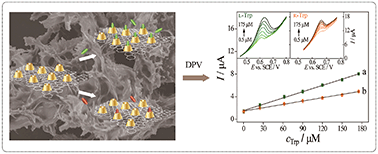3D graphene/hydroxypropyl-β-cyclodextrin nanocomposite as an electrochemical chiral sensor for the recognition of tryptophan enantiomers†
Abstract
A novel and facile chiral sensing platform has been designed for electrochemical enantiomer recognition based on the coupling of three-dimensional-graphene with hydroxypropyl-β-cyclodextrin (3D-G/HP-β-CD). The chiral platform synergistically exploits HP-β-CD as a supramolecular chiral recognizer and 3D-G as an electrochemical indicator, to recognize tryptophan (Trp) enantiomers by differential pulse voltammetry (DPV) approach with significantly discernable electrochemical signals. The different host–guest interactions of D- and L-Trp with HP-β-CD reveal high binding affinity to target L-tryptophan for sensing tryptophan isomers. Moreover, we found that the peak currents of the two enantiomers showed a linear response in the concentration range of 0.5–175 μM with low detection limits of 9.6 nM and 38 nM for L- and D-Trp (S/N = 3), respectively, exhibiting remarkable sensitivity, fine reproducibility as well as great stability. This process, which is the initial demonstration of cyclodextrin-functionalized 3D-G for an electrochemical chiral recognition application, provides a new strategy for enantiosensing.



 Please wait while we load your content...
Please wait while we load your content...